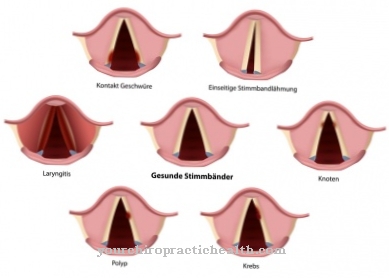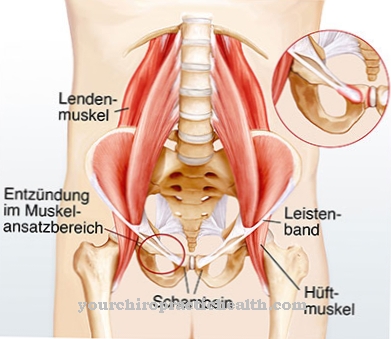SIRS is an abbreviation for that Systemic Inflammatory Response Syndrome. In the context of infections, medicine also speaks of sepsis in this immunological whole body inflammation. Clearance of the inflammatory focus is an important treatment step.
What is SIRS?
.jpg)
© timonina - stock.adobe.com
Inflammatory reactions are signs of an immunological activation. The immune system wants to remove pathogens or other harmful substances from the organism through immunological inflammation. Foreign substances, antigens or abnormal tissue conditions trigger a stimulus that initiates the immunological defense reaction. The respective inflammatory reaction can take place in the affected organs and the surrounding tissues or systematically affect the entire body.
Ultimately, any stimulus above a physiologically normal level can activate inflammation. This applies to physical stimuli as well as mechanical stimuli. In addition to thermal, radiation and chemical causes, inflammation can also be caused by allergens or autoallergens and actual pathogens such as viruses. SIRS stands for systemic inflammatory response syndrome and thus an inflammatory response throughout the body.
Instead of local inflammation, the systemic inflammatory response syndrome is a systemic inflammation that spreads from a directly affected tissue in the body. The clinical picture is similar to blood poisoning. In contrast to sepsis, however, no infections can be detected with SIRS.
causes
Ultimately, sepsis is an infectious special form of SIRS. The systemic inflammatory response syndrome can thus be triggered by even more circumstances than sepsis, but it is basically the same. The systemic inflammatory reaction without a detectable infection can have an immunological cause. The clinical picture can also be caused by chemical connections.
For example, in acute pancreatitis, which backs up bile acid in the pancreatic ducts and thus damages the epithelium of the pancreas or makes it permeable to various substances. Thermal triggers can also be the cause of SIRS. These include, for example, burns of a certain size and severity. Among the mechanical triggers, major operations are one of the most important causes of SIRS.
In particular, interventions with an extracorporeal circuit are observed as triggers for the inflammatory reactions. In addition to cardiac surgery, large wound areas can also cause SIRS. Severe trauma, bleeding, ischemia or anaphylaxis are also possible triggers. Serious diseases such as necrotizing pancreatitis are an equally conceivable cause of the systemic inflammatory response of the entire body.
Symptoms, ailments & signs
Various parameters indicate the SIRS. However, there are usually only around two of them in one patient at the same time. The criteria for making a diagnosis include, for example, a body temperature below 36 or above 38 degrees Celsius. The same goes for a heart rate above 90 per minute. Tachypneas with respiratory rates above 20 per minute and a paCO2 below 32 mmHg or oxygenation indices below 200 are also conceivable.
A white blood cell count of less than 4000 / mm3 or more than 12000 / mm3 is also a possible sign of SIRS. The same applies to less than ten percent of immature leukocytes. In the laboratory, hypophosphataemia and thrombocytopenia turn out to be additional markers for the SIRS. A drastic drop in fibrinogen or factors II, V and X can also provide clues about the clinical picture.
CRP and ESR are usually highly positive and the procalcitonin is constantly increasing. Increasing IL-6 and IL-8 are also an indication, since they are the main mediators of the acute phase reaction.
Diagnosis & course of disease
The doctor makes the diagnosis of a SIRS based on the parameters mentioned. At least two of the above criteria must be met for diagnosis. The combination of fever and abnormal leukocytosis is the most common combination in diagnosing SIRS and indicates an adequate or excessive immune response.
A body temperature below 36 degrees Celsius in combination with leukopenia is also called a cold SIRS and indicates a weak immune system. If two or more of the criteria mentioned are accompanied by a detectable infection, the systemic inflammatory response syndrome is no longer referred to, but sepsis. The course depends heavily on the clinical picture in the individual case.Treatment as early as possible improves the prognosis. The initiation of therapy before the detection of possible pathogens is the recommended standard.
Complications
SIRS can cause a number of symptoms and complications over the course of the disease. Whole-body inflammation initially causes the body to overheat - symptoms such as fever and hyperventilation occur. If the body temperature rises to over 41 degrees Celsius, life-threatening cardiovascular complaints can occur. In the event of a lack of treatment, circulatory collapse or heart failure eventually occurs.
Accompanying symptoms such as dehydration and deficiency symptoms can also be fatal if left untreated. Due to the weak immune system, there is also an increased risk of infections. As a result, inflammation can occur throughout the body, which in the worst case can lead to blood poisoning. If the internal organs or the skin are affected, further complications arise, for example kidney failure and abscesses.
Treatment is also associated with risks. The administration of antibiotics can lead to gastrointestinal complaints, headaches, muscle and body aches and skin irritations. Allergies and intolerance reactions cannot be ruled out either. Surgery can lead to infection, bleeding and nerve injuries. In some cases, allergic reactions to the substances and materials used can also occur.
When should you go to the doctor?
Medical treatment is definitely necessary with SIRS. In the worst case, the affected person can also die due to the symptoms of the syndrome, so an early diagnosis is very important. In most cases, the life expectancy of the patient is significantly reduced by SIRS. A doctor should be consulted if the patient suffers from a body temperature that is significantly too low or significantly too high. This can lead to very high-frequency breathing or gasping.
Many people have a fever or even loss of consciousness. If these symptoms occur, a doctor should be consulted immediately. A reduced resistance of the immune system can also indicate this disease and should always be examined by a doctor. First and foremost, a general practitioner can be seen at SIRS. Further treatment is usually carried out by a specialist. Whether the treatment will be successful cannot always be predicted. In an emergency, go to the hospital or call the emergency doctor.
Therapy & Treatment
To treat SIRS, the inflammation focus must first be identified. When the focus of the inflammatory reaction has been detected, surgical intervention is carried out to clean up the focus. Antibiotics are given initially and correspond to broad coverage after suspicion. This step can be described as calculated therapy. An antibiogram is created to clarify any resistance.
If necessary, a switch to a specified antibiotic therapy is then carried out. The drug and surgical steps are rounded off by a volume supply that creates a CVP above eight to twelve mmHg and a mean arterial pressure above 65 mmHg. If the volume is not sufficient to achieve the value, treatment with vasopressors or positive inotropic substances such as norepinephrine is considered as soon as possible.
The therapy pursues a central venous oxygen saturation of more than 70 percent, which is maintained in the further course of therapy. In addition, an ideal Hb concentration with a hematocrit above 24 to 30 percent is aimed for. If necessary, this value can be achieved by adding red blood cell concentrate. Ventilation with a tidal volume of six milliliters per kilogram of body weight serves to protect the lungs, with the open lung concept being followed with a PEEP above the inflection point.
prevention
The SIRS is a relatively natural response. If necessary, rapid treatment can prevent severe forms of the disease. Above all, the early clearance of the inflammatory focus can be described as a preventive measure.
Aftercare
The entire organism is affected by the systemic inflammatory response syndrome (abbreviated as SIRS). If left untreated, the syndrome can develop into life-threatening sepsis with organ failure. In addition to treating the underlying disease, medical follow-up care is necessary. The aim is to avoid organic consequential damage and septic shock. For a favorable course of the disease, therapy and follow-up care must be carried out in a timely manner within one day.
The person concerned receives antibiotic and / or anti-inflammatory agents. With the help of the medication, the inflammation should subside, and the vital functions must be closely monitored. After the emergency treatment, the patient should be out of danger. The support is intended to prevent the SIRS from returning. Further follow-up care depends on the causal disease; it will be initiated in the clinic.
During drug therapy, the specialist checks the healing progress. Aftercare ends with healing. In the case of surgical treatment, it is applied in the medium to long term. After being discharged from the clinic, the patient must visit the family doctor at fixed intervals. The postoperative condition is determined there. Follow-up care ends when the affected person is found stable.
You can do that yourself
The possibilities of self-help in this disorder are limited to taking measures to improve general well-being and strengthen the immune system. The patient's organism can be supported with a balanced and vitamin-rich food supply. Adequate oxygen, avoidance of pollutant environments and daily exercise in the fresh air help the body build defenses.
To alleviate gastrointestinal complaints, it is important to have a food intake that is tailored to the patient's needs. Avoid alcohol, nicotine, fatty foods, or overeating. Regular balancing movements, warming baths or massages are recommended to put a stop to muscle and limb pain. Physical overexertion is also to be avoided, as is the assumption of a one-sided or rigid posture. If you feel unwell or feel unwell, you should take breaks so that the organism has time to regenerate. If you have a headache, it is advisable to keep calm and reduce stressors as best as possible.
Cognitive training can be used in everyday life to relieve emotional stress and promote inner balance. Various relaxation techniques also help relieve existing symptoms. Although there is no recovery, methods such as yoga or meditation can improve the patient's sense of well-being in the area of self-help.


.jpg)

.jpg)
.jpg)


















.jpg)



